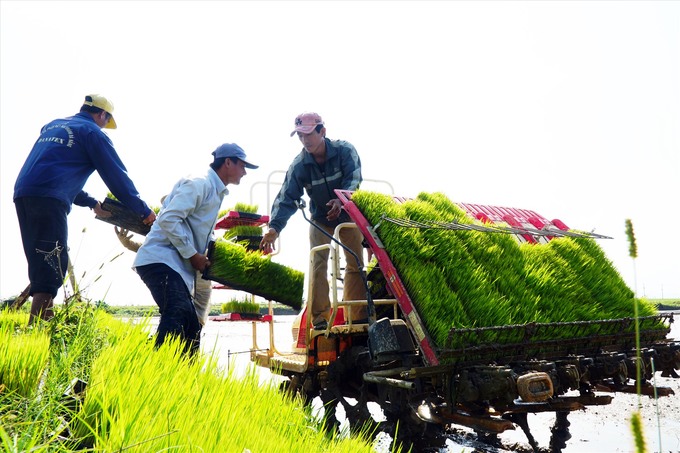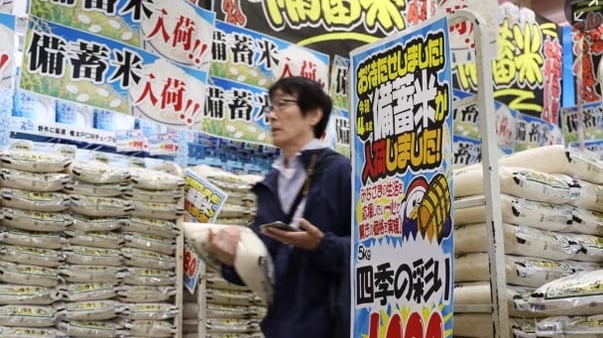June 21, 2025 | 01:22 GMT +7
June 21, 2025 | 01:22 GMT +7
Hotline: 0913.378.918
June 21, 2025 | 01:22 GMT +7
Hotline: 0913.378.918

Minister Le Minh Hoan emphasizes that the agricultural sector must thoroughly assess its shortcomings and limitations in the first quarter of 2023. Photo: Pham Hieu.
During the first quarter meeting on March 30 with the Ministry of Agriculture and Rural Development, the Center for Digital Transformation and Agriculture Statistics reported that the total export and import turnover of agricultural, forestry and fishery products were estimated at 20.63 billion USD for the first three months of 2023. This is a decrease of 11.2% over the same period in 2022.
To be more specific, exports were estimated at 11.19 billion USD, a decrease of 14.4% over the same period last year; imports were estimated at 9.44 billion USD, a decrease of 7.2% over the same period last year; trade surplus was estimated at 1.76 billion USD, a decrease of 39.6% over the same period last year.
Many major export products suffered a decline in export value compared to the same period last year. Exports of agricultural products reached 5.73 billion USD, an increase of 3.8% over the same period last year; forest products reached 3.11 billion USD, a decrease of 28.3% over the same period last year; seafood products reached 1.79 billion USD, a decrease of 29.0% over the same period last year; livestock production reached 115 million USD, an increase of 46.5% over the same period last year.
Regarding export markets in the first three months of 2023, markets in Asia accounted for 48.8% of the market share, the United States 20.3%, Europe 12.8%, Oceania 1.4% and Africa 1.2%.

Deputy Minister Phung Duc Tien emphasized the importance of science and technology in each production field within the agricultural sector. Photo: Pham Hieu.
China is the largest export market with a total export value estimated at USD 2.4 billion (or 21.5% of the market share), followed by the United States with USD 2.04 billion (or 18.2% of the market share). With an export value of USD 936 million and an 8.4% market share, Japan is the third-largest market, and South Korea is the fourth-largest with an export value of USD 528 million and a 4.7% market share.
Multiple imported products saw a decrease in value compared to the same period last year. Namely, the import value of agricultural products reached USD 5.82 billion, a decrease of 10.3%; aquatic products reached USD 708 million, an increase of 30%; forest products reached USD 513 million, a decrease of 25.4%; livestock products reached USD 741 billion, an increase of 1.5%; production input group reached USD 1.64 billion, a decrease of 3.9%.
Asia accounted for 29.3% of Vietnam's import market share, the Americas accounted for 25.5%, Oceania accounted for 7.1%, Europe accounted for 4.0% and Africa accounted for 2.9%. Brazil, Argentina, China and the United States are the three largest suppliers of agricultural, forestry and fishery products to Vietnam in the first quarter of 2023 with an import market share of 9.9%, 8% and 6.7% respectively.

According to Deputy Minister Nguyen Hoang Hiep, droughts are forecast to occur in the Central and Central Highlands regions in 2023. Consequently, the lack of water will prevent rice irrigation in the Red River Delta region. Photo: Pham Hieu.
According to Minister Le Minh Hoan, agricultural production remained relatively stable through the first three months of the year. However, the agricultural sector needs to thoroughly assess its shortcomings and limitations. Most importantly, the sector needs to acknowledge that the growth rate has failed to meet the national plan, and the total export turnover for agricultural, forestry and fishery products has decreased.
"We were alerted to these issues since the end of 2022. It's inevitable that when market shares shrink, the prices will drop," Minister Le Minh Hoan said.
Minister Le Minh Hoan said that although market rules are unchangeable, it is possible to open the supply band within the limit, freeing up the capacity for the agricultural sector in moderation.
Accordingly, relevant units need to focus on the domestic market as well as reinforce negotiations and connections with international markets. In addition, it is necessary to remove existing bottlenecks at border gates through various means. Furthermore, the government must provide active support in resolving difficulties for businesses.

Deputy Minister Nguyen Quoc Tri believes that the authorities need to divert more attention to the unusually high number of forest fires in recent years. Photo: Pham Hieu.
According to the Ministry of Agriculture and Rural Development, approximately 253 hectares of forest land area were damaged in the first three months of the year; this is an increase of 14.7% over the same period last year. Forest fires specifically affected 71.4 hectares of forest land, which is 7.7 times higher than the same period last year.
Deputy Minister of Agriculture and Rural Development Nguyen Quoc Tri reported the number of forest fires has increased unusually, and a single forest fire can devastate a wide area of forest land.
Subsequently, Deputy Minister Nguyen Quoc Tri proposed the Administration of Forestry to assess the situation and take timely measures to manage, direct, urge, inspect, check, forecast and alert forest owners regarding forest fire prevention in the immediate future, with special attention given to time frames when forest fires are most likely to occur
According to Deputy Minister Nguyen Hoang Hiep, the Ministry of Agriculture and Rural Development has coordinated with the Vietnam Electricity Group and local governments to collect water for winter-spring rice crop in the Midlands and Northern Delta provinces. The Ministry also urged stakeholders to regularly monitor water sources; implement drastic solutions to prevent and combat drought, saltwater intrusion, flooding and waterlogging; ensure the safety of irrigation works and supply water for agricultural production.
“Droughts are forecast to occur in the Central and Central Highlands regions in 2023. Consequently, the lack of water will prevent rice irrigation in the Red River Delta region. Additionally, the Mekong Delta region is affected by the fresh water - salt water imbalance. The Ministry of Agriculture and Rural Development has directed various units to calculate and deploy appropriate measures until the end of the year," said Deputy Minister Nguyen Hoang Hiep.

The agricultural sector sets a target of 2.9 to 3.0% growth in total agricultural value added for the second quarter of 2023. The total export turnover of agricultural, forestry and fishery products is expected to be nearly 14 billion USD. Photo: TL.
Deputy Minister of Agriculture and Rural Development Phung Duc Tien emphasized the necessity of removing obstacles in the administrative procedures for businesses, thereby creating a favorable, open and transparent environment for capacity growth of each branch and each field in the agricultural sector.
Deputy Minister Tien also emphasized the importance of science and technology in each production field within the agricultural sector. Science and technology must be associated with the market to transition from agricultural production mindset to agricultural economy mindset. The product and value of the commodity chain must be the primary focus of scientific research.
“Preliminary processing and processing in livestock production, cultivation, aquaculture, etc. must be guided towards circular economy. However, the processing capacity is presently limited. It is necessary to assist businesses in improving competitiveness and increasing added value for the agricultural sector. These tasks will help Vietnam's agricultural sector produce large goods and fully utilize international integration," said Deputy Minister Phung Duc Tien.
During the first quarter of 2023, the growth rate of the sector has failed to meet the established national plan. The total export turnover of agricultural, forestry and fishery products as well as the trade surplus decreased compared to the same period last year.
This is caused by the disrupted global economy in 2023; influence from the Russia-Ukraine military conflict; High inflation in countries around the world has reduced consumption and import demand.
In addition, many countries re-exported agricultural products and increased supply in the market after the Covid-19 pandemic was controlled. On the other hand, many businesses in the domestic market have not signed new export orders for 2023.
The global market is expected to fluctuate and challenged by economic competition, geopolitics, and military conflict factors in the second quarter of 2023.
China will reinstate customs clearance of goods as well as expand its production area for durian, dragon fruit, etc. to remain self-sufficient. These are also major export items from Vietnam to China.
Vegetables and fruits in the domestic market have an abundant and relatively stable supply. Many agricultural products are approaching their harvesting season. Food prices are forecast to be at a profitable level due to increased consumer demand as a result of the Lunar New Year.
The agricultural sector sets a target of 2.9 to 3.0% growth in total agricultural value added for the second quarter of 2023. The total export turnover of agricultural, forestry and fishery products is expected to be nearly USD 14 billion.
Translated by Nguyen Hai Long

(VAN) Last week, the U.S. Department of Agriculture (USDA) released its June World Agricultural Supply and Demand Estimates (WASDE), raising projections for both Indian rice production and U.S. rice imports for the 2025/2026 marketing year.
/2025/06/17/2344-1-131758_261.jpg)
(VAN) Amid tariff risks and growing trade barriers in the U.S. market, Australia is emerging as a promising destination to sustain the growth momentum of Vietnam's shrimp exports.
/2025/06/17/2013-1-nongnghiep-112009.jpg)
(VAN) This notable growth trend reflects the global taste for fresh, nutritious fruits and the expanding use of lychees across various sectors.

(VAN) The political and cultural insulation of Japan’s beloved grain is falling apart, and experts warn the country’s relationship with the staple will have to adapt.

(VAN) Noting risks, report examines impacts of avian influenza, changing trade patterns since 2022, fish fraud, and shipping industry’s net-zero goals.

(VAN) Mr. Tran Quang Bao, General Director of the Forestry and Forest Protection Department, met and worked with the International Wood Products Association to promote cooperation in the field of timber trade.

(VAN) China's outbound shipments of rare earths in May jumped 23% on the month to their highest in a year, though Beijing's export curbs on some of the critical minerals halted some overseas sales.